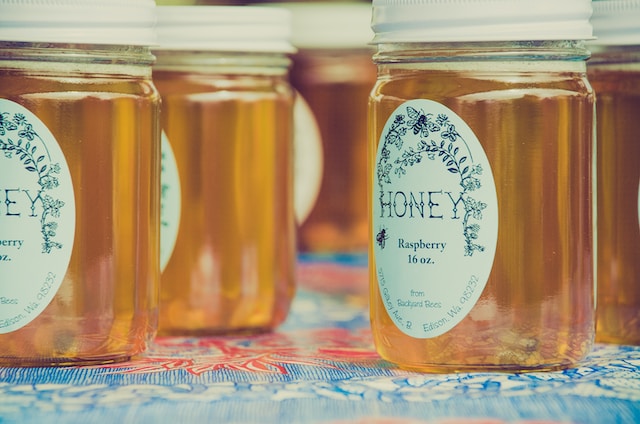I'm always delighted when scientists set out to verify the efficacy of ancient natural remedies. I'm even more delighted when the results confirm what we've known since ancient times!
This was precisely the case in a recent study, which examined the antiseptic virtues of oxymel, a panacea already praised in the days of Hippocrates.
A great sweet and sour combination!
Oxymel, a blend of miel and vinegarwas recommended in ancient Greece to treat infections and inflammation. Its effectiveness is such that it has stood the test of time, from the Middle Ages to the present day.
How can a remedy composed of just two natural ingredients produce such good results? That's what Freya Harrison and her team of researchers set out to find out. The results of their analysis have been published in the journal Microbiology and they are inspiring.
Especially as their tests focused on bacterial biofilms. Biofilms are clusters of bacterial cells protected by a kind of matrix and attached to a surface, making them very difficult to eradicate.
Indeed, thanks to this protection, they are much more resistant to antibiotics, and this is becoming a real problem, particularly in hospitals, where biofilms can form on surgical instruments, for example.
At the same time, the miel and the vinegar are renowned for their antiseptic and antibiotic properties. But it's the synergy of the two ingredients that proves formidable.
Indeed, the miel alone, just like the vinegaris not effective against bacterial biofilms. On the other hand, the two together manage to destroy a good proportion of the bacteria protected by their biofilm! A miracle recipe, worthy of the greatest alchemists.
Le miel therapeutic
Le miel has proven anti-infectious properties.
It prevents bacterial, viral or fungal proliferation, thanks to an enzyme, glucose oxidase, which produces small quantities of hydrogen peroxide (a molecule found in hydrogen peroxide) on contact with oxygen.
The slightly acidic pH of miel completes its fatal action on bacteria. That's why all miels have anti-infectious properties that may differ according to their origin.
So.., fir honey is recommended for the treatment of respiratory ailments and colds, while miel chestnut, an excellent healing agent, will help heal wounds in particular.
The different honeys used by the research team all showed results when combined with the vinegarbut one in particular proved even more effective against biofilms: le miel.
It comes from the flowers of the tea tree (leptospermum scoparium)also known as manuka, grows wild only in certain regions of New Zealand and Australia.

Ce miel contains a molecule, methylglyoxal, which gives it exceptional anti-infectious power. The concentration of methylglyoxal (MGO) is ten times higher in manuka honey than in all other honeys.
But the higher it is, the more the miel is active.
If you're looking to buy some, look for the MG or MGO index on the label, which can range from 100 to 1000 (1000 milligrams of MGO for one kilogram of honey). Sometimes, manufacturers display a UMF index instead.
It takes into account the level of MGO and other things like leptosperin, a molecule derived from the manuka plant that helps gauge the purity of honey.
The rating system starts at UMF 5 and goes up to UMF 33. UMF 5 corresponds to a miel pleasure that has no curative virtues. If you're looking for a manuka honey with therapeutic properties, you'll need to look for those with a UMF of at least 10.
Le vinegar therapeutic
It is acetic acid, which is found in vinegarwhich gives it its many health benefits. It is also widely used in the pharmaceutical industry.
The acetylation of a molecule, i.e. its synthesis with acetic acid, enhances the effect of certain drugs. All vinegars contain around 90% water and 5-8% acetic acid.
In general, it's the vinegar cider, touted for its health benefits. Research highlights its ability to fight diabetes and its powerful antimicrobial action.
As a gargle, for example (1 tablespoon of cider, diluted in a large glass of lukewarm water), it's perfect for fighting sore throats.
As for the oxymel tested by Freya Harrison and her team, it seems that the pomegranate vinegar was the most potent when combined with honey.
Hippocrates' oxymoron
To combat winter ailments (colds, sore throats, coughs...) or intestinal problems (nausea, stomach aches, digestive problems, gastroenteritis, etc.), you can easily make your own oxymel.
The recipe is simple! Buy a coupon vinegar of cider or grenade bio. Choose the miel of your choice, bearing in mind that manuka is the most effective but also the most expensive.
And finally, add a few medicinal plants chosen according to your health problem (e.g. hyssop for the flu, sage for sore throats, lemon balm for the intestines, plantain for coughs...).
Place two to three tablespoons (or teaspoons if your jar is small) of dried herb(s) in a canning jar of your choice, then fill halfway with vinegar and top up with honey.
Close the jar and leave for three weeks, turning from time to time. Filter and store in an amber bottle. Take one tablespoon undiluted, or diluted in a small amount of water, in the morning on an empty stomach, until your symptoms disappear.
Your oxymel will keep for 6 months to 1 year. If you don't feel like taking the plunge, I highly recommend oxymel from Ballot-Flurin. An exceptional product, handcrafted, biodynamic and unpasteurized!
It's made with 50% wildflower honey, French cider vinegar and peppermint.



